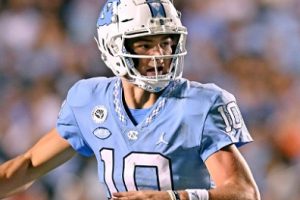By Chet Gresham – @ChetGresham
Follow @walterfootball for updates.
Fantasy football is fun. That statement is true most of the time and the reason the game has grown exponentially, but if you are just getting into the game, it can be a bit overwhelming in the beginning. I’m going to take you through some of the basics so you can start your fantasy career on an even playing field.
First off, you don’t have to be an expert to win a fantasy football league. If you are an expert you might have an advantage, but this game is notorious for taking down the smartest football minds year after year. In most leagues, there are only 13 matchups before the playoffs, which means there is very little room for error in your weekly head-to-head matchups. Luck does play a big part in this game, but so does knowledge and persistence. And when you put them together, it means that rookie fantasy footballers have a chance to win even tough leagues with enough preparation.
So, you are in a league. Woohooo! Now check out the scoring and settings. This is the most important thing you can possibly do. Yes, Aaron Rodgers is good but, if the scoring shows that quarterbacks get -4 points for each touchdown pass, well, you’ll want to draft Kevin Kolb.
For the most part, standard leagues will have 12 teams, one quarterback, two running backs, two wide receivers, one tight end, a flex player where you can choose between a running back and a wide receiver, a kicker and one defense/special teams.
For standard scoring, you’ll see something like this:
Touchdown Pass = 4 points
Interceptions Thrown = -2 points
Every 25 passing yards = 1 point
Touchdown Rush = 6 points
Every 10 rushing yards = 1 point
Touchdown Reception = 6 points
Every 10 receiving yards = 1 point
Each Fumble Lost = -2 points
These settings are the norm, but there are as many iterations in scoring as there are leagues, so if you see something different than above, you’ll know that more research is needed into what makes your league different and if you need to change your drafting strategy to accommodate.
Below, I will go through a few of the more popular non-standard leagues out there.
Points-Per-Reception Leagues
PPR leagues are quickly overtaking standard leagues as the most popular. I don’t have hard facts to give you, but I haven’t been in a non-PPR league in years now, and I play in way too many leagues.
You’ll usually see either .5 or one point given for every reception a running back, wide receiver or tight end makes. One point is usually the one I run into the most, and I prefer it because it is just easier to lift the best pass-catching running backs in your draft rankings so you can reach for them and feel good about it. The .5-point PPR leagues feel too much like standard leagues and don’t feel like you are changing the strategies as much.
The extra receiving points really help out pass-catching running backs like Devonta Freeman, Danny Woodhead, Theo Riddick, Duke Johnson and any running back who stays in the game on passing downs. Players like Jeremy Hill, Adrian Peterson, Chris Ivory and LaGarrette Blount, who are either not good receivers or lose work on third downs or both, lose value in PPR leagues.
Wide receivers and tight ends can move a bit due to one-point PPR leagues, as receivers who catch many short passes, like Jarvis Landry, Golden Tate, Randall Cobb and Michael Crabtree gain a bit of value, while players who are used more often as deep threats like DeSean Jackson, Sammy Watkins, Allen Hurns and John Brown lose some value due to their lower reception numbers.
Two-Quarterback Leagues
Two-quarterback leagues are nice because they give quarterbacks more worth in your fantasy leagues. Unlike real football, fake football usually doesn’t put that much importance on the position because you only need one starting quarterback on your team. In real football, it is quite difficult to find a playoff-caliber quarterback, but if you are in a 12-team fantasy league, there are only 12 starters needed at the position. I can name you 12 very good quarterbacks who will be worth drafting, whereas some leagues allow you to start 3-5 wide receivers, and I cannot tell you 60 starting wide receivers who I’d be happy with on my fantasy team.
So that brings us to 2QB leagues. With two starting quarterbacks needed for your team, you need to draft two out of 24 possible starters who other teams are going to be after. That makes things much tougher and means you have to delve into that quarterback market earlier in drafts than usual. I will go into more detail about my 2QB strategy in a full article, but the goal usually for me is to get one solid signal-caller who I would want as my starter in a single-quarterback league and then one who I like for upside who you usually can get late in single-quarterback league drafts. The question is, when can you safely pick your quarterbacks without getting left out in the Geno Smithian barren landscape? That is a tough question to answer unless you know your leaguemates extremely well, so I will reach for a quarterback I like much earlier than I would like.
One wrinkle in 2QB leagues is the superflex position. The superflex is a starting position that allows you to put in a QB, RB, WR or TE. This means you are in a de facto 2QB league because quarterbacks are almost always the position you want to put in at superflex, but it also allows you some leeway if your quarterback is on a bye or injured. If you are setting up your own 2QB league, this is my preferred way of configuring the settings, because it’s just not fun to have bad luck completely take you out of the running for a week or two.
Two-Tight End Leagues
Like quarterbacks, tight ends get short changed in standard leagues, so allowing two-tight end starters gives them more weight. This also can mitigate the advantage that the Rob Gronkowski owner has, as he or she will need to pick another lesser tight end who will not always be outscoring the bulk of the tight ends in the league.
Tight ends will go quickly in these leagues, but the advantage of one average tight end over a scrub tight end isn’t quite as steep as it is for quarterbacks, so looking for later tight ends who you think have good upside is still a viable option.
Six-Points-Per-Passing TD Leagues
Standard leagues usually give you four points per passing touchdown. The extra two points in six-point passing touchdown leagues can help widen the gap between the great and not-so-great quarterbacks, but, even with the extra points, it does not boost quarterbacks up like two-quarterback leagues. Your league will still only start 12 quarterbacks, so there will be plenty of value later in drafts.
The players who are hurt the most by this scoring change are running quarterbacks. If their rushing touchdowns count as six points, while their passing touchdowns also count as six points, then quarterbacks who throw 30 touchdowns versus quarterbacks who throw 20 touchdowns and rush for five touchdowns makes for a discrepancy in favor of the quarterback with more passing touchdowns. In this example, the passing quarterback scored 180 points versus the rushing quarterbacks scoring 150, but if passing touchdowns were worth the more-standard four points, it would be just 120 points for the passing quarterback and 110 for the rushing quarterback. That’s not a small difference when you are deciding on whom to draft as your fake team’s signal-caller.
Return Yardage Leagues
These leagues aren’t that popular, but I’ve seen them in my travels, and you really need to be aware of this scoring setting. If I can, I always look at the previous year’s results using the exact scoring as the league I’m in so I can get a feel for what kind of players score well.
When you check the previous year’s scoring for return yardage leagues, you will usually see some odd names near the top, like Darren Sproles, Jarvis Landry, Tyler Lockett, Travis Benjamin, Dwayne Harris, Knile Davis, Cordarrelle Patterson and the like. The biggest boon in these leagues are players who return kicks and also are a big part of the offense, as some on this list were last year. Of course, returners are a fickle bunch and often change from year to year or even during the season, so you need to do your research every year to see who is ensconced as the kickoff and punt returner for each team.
Large Leagues
When you are in a 14- or even 20-team league, you need to look at positional scarcity when formulating a strategy. For the most part, your rankings will stay the same as your standard-12 team league, but if you are in a big league, player scarcity becomes scarcer. You go from 12 to 14 or more teams, then that many quarterbacks or tight ends will go off the draft board as starters. You will most likely want to go after those positions earlier than you usually would.
The opposite of the scarcity issue for tight ends and quarterbacks becomes true when you go to eight- or 10-team leagues. If you only need 8 or 10 starters in your league, then feel free to go after the wide receiver and running back positions that require 30-40 total starters.
Always run the scarcity numbers for your league to give you an overall idea of how many starters will be chosen, which you can then transpose onto your rankings and see how many of each position you would feel comfortable drafting as your starters. Fantasy football is often a numbers game, and you want to be on the right side of those numbers.
Who to Draft?
Draft A Whole Bunch Of Bench Running Backs After You’ve Solidified Your Wide Receivers
Solid wide receivers are much easier to predict than running backs. There are a few reasons for this, but one of the easiest to conceptualize is that running backs take the ball and run toward a bunch of 300=pound men who can outrun the best sprinter on your high school team, whereas a wide receiver does his best to avoid contact and the rules continue to make things easier for receivers who are left out to dry by their quarterbacks over the middle of the field.
Of course, there are some running backs I would want early in drafts, but there are more wide receivers due to their consistency and safety. You also don’t draft late-round receivers who turn out to be studs, but that happens more often with running backs. Last year, Devonta Freeman, DeAngelo Williams, David Johnson, Chris Ivory and Danny Woodhead all were drafted later than the 28th running back taken in the draft, yet all five ended up in the Top-10 for fantasy running backs. Doug Baldwin was the only outlier in the wide receiver Top-10 last year.
Don’t Draft According To Bye Weeks
If you are afraid of drafting two wide receivers with the same bye week, then you are putting too much of an emphasis on their bye weeks. Pick the player you feel is the best and then let the bye week situation clear up later on. Your team won’t look the same by the time that horrific bye week comes around anyway.
Learn Average Draft Positions (ADP)
ADP shows you where others have been drafting players in mock drafts and regular drafts. This gives you some structure to build a draft strategy on. Is Marvin Jones going much later than you are willing to take him? Great! Now you can wait a little longer and draft him a round later and get another player with a higher ADP in the round you were willing to draft Jones in. Of course, it won’t always work out exactly like ADP shows, but it’s a good framework to learn from.
Use A Cheat Sheet
This can be a handwritten group of draft targets or a detailed excel spreadsheet of rankings and tiers, but have something on hand to guide you through a draft. No matter what, at some point in the draft you are going to feel stumped, and that might make you nervous and push you to draft someone you end up hating.
Don’t Draft A Defense or Kicker Until the Last Two Rounds and Petition your league to do Away with Kickers completely:
Both of these positions change so much from year to year that it is extremely difficult to predict how they will do, which makes reaching for one a high-risk move.
In drafts that take place before the starting positions have been finalized, I’ll often not take a kicker or defense so I can select a player who has good upside if he beats out a starter. Then when it gets closer to the start of the season, I can drop my weakest players for a kicker and defense based on the Week 1 matchups.
Streaming Can Work
No, this isn’t about illegally watching NFL games online; this is about picking up positions off the waiver wire who have good matchups the following week or weeks. Usually, this works the best with defenses, but I’ve also seen good results with kickers, quarterbacks and tight ends. Sometimes, a matchup against a weak defense is as fruitful as having a stud player against a tough defense.
Mock Draft As Much As You Can
This allows you to draft from multiple positions and get a feel for strategy. I also like to do it for the fun of it. Drafting is one of the most exciting parts of this game, so practicing it is pretty fun as well.
When you mock, you should try different strategies. What if I went with two running backs to start out of the seventh pick? You then go through the draft and look back and decide if you might have had a better draft if you had picked a wide receiver second or if a certain player had dropped one more spot you would have had a much better draft, and so on and on. Mocks truly help you get your head around multiple strategies, but make sure you are mocking with the same settings as your real league, and if there are a bunch of auto-drafters in your mock, then just leave, it isn’t worth your time.
Don’t Buy A Fantasy Football Magazine
The information in a magazine is too old to be of much use. Stick with WalterFootball.com and other sites that continue to provide up-to-the-minute analysis and rankings.
Be Flexible
You are going to go into a draft with some solid thoughts on what you want to do, but if you have done your research, you should have multiple strategies based on where you pick and what players are available when. This is where mock drafting gives you a little muscle memory and makes being flexible much easier.
Have Fun and Take Risks
Remember this is a game and not life or death. Reach for the players you want. Trade for the players you want. Don’t freeze up completely and do nothing because you don’t want to lose because you took too big of a risk. If you are certain that Andrew Luck is going to blow every quarterback out of the water this year, then take him early. I would advise you not too take a quarterback early, but who the hell am I? This is your team and win or lose, you are the one making the decisions. Kick some ass!
For more recommendations, check out WalterFootball.com’s Fantasy Football Rankings.
More 2015 Fantasy Football Articles:
Fantasy Football Rankings
2015 Fantasy Football Rankings:
2015 Fantasy Football Rankings: Quarterbacks - 9/10 (Walt)
Chet Gresham's Fantasy Football Quarterback Rankings - 9/4 (Chet)
2015 Fantasy Football Rankings: Running Backs - 9/10 (Walt)
Chet Gresham's Fantasy Football Running Back Rankings - 9/4 (Chet)
2015 Fantasy Football Rankings: Wide Receivers - 9/10 (Walt)
Chet Gresham's Fantasy Football Wide Receiver Rankings - 9/4 (Chet)
2015 Fantasy Football Rankings: Tight Ends - 9/10 (Walt)
Chet Gresham's Fantasy Football Tight End Rankings - 9/4 (Chet)
Chet Gresham's Fantasy Football Flex Rankings - 9/4 (Chet)
2015 Fantasy Football PPR Rankings - 9/4 (Chet)
2015 Fantasy Football Rankings: Defenses - 8/27 (Walt)
2015 Fantasy Football Rankings: Kickers - 8/27 (Walt)
Fantasy Football Rookie Rankings - 5/14 (Walt)
Fantasy Football Rookie Rankings: Dynasty - 5/14 (Walt)
2015 Fantasy Football Mock Drafts:
2015 Fantasy Football Mock Draft Simulator - 9/10 (Walt)
2015 Fantasy Football Mock Draft - 9/3 (Walt)
2015 Fantasy Football Mock Draft - 8/27 (Walt)
2015 Fantasy Football Mock Draft - 8/20 (Walt)
2015 Fantasy Football Mock Draft - 8/13 (Walt)
2015 Fantasy Football Experts Draft - 8/11 (Chet)
2015 Fantasy Football Mock Draft - 8/7 (Walt)
2015 Fantasy Football Mock Draft - 8/6 (Chet)
2015 Fantasy Football Mock Draft - 7/31 (Walt)
2015 Fantasy Football Mock Draft - 7/23 (Walt)
2015 Fantasy Football Mock Draft (2-QB) - 7/15 (Chet)
2015 Fantasy Football Mock Draft (PPR) - 7/6 (Chet)
2015 Fantasy Football Cheat Sheets:
2015 Fantasy Football Cheat Sheet: Top 250 - 9/10 (Walt)
2015 Fantasy Football Cheat Sheet: Top 250 PPR - 9/10 (Walt)
2015 Fantasy Football Cheat Sheet: Top 250 2-QB - 9/10 (Walt)
2015 Fantasy Football Cheat Sheet: Top 250 Touchdown League - 9/10 (Walt)
2015 Fantasy Football Cheat Sheet: Custom - 9/10 (Walt)
2015 Fantasy Football: Dynasty Rankings - 9/10 (Walt)
Chet Gresham's Fantasy Football Top 200 Rankings - 9/4 (Chet)
Chet Gresham's 2015 Fantasy Football Positional Cheat Sheet - 9/4 (Chet)
Chet Gresham's 2015 Fantasy Football Overall Cheat Sheet - 9/4 (Chet)
2015 Fantasy Football Articles:
2015 Fantasy Football Stock Report: Training Camp - 9/10 (Walt)
Fantasy Football Tight End Matchup Chart: Week 1 - 9/9 (Chet)
Fantasy Football Wide Receiver Matchup Chart: Week 1 - 9/8 (Chet)
2015 Fantasy Football Sleepers - 9/8 (Walt)
Fantasy Football Running Back Matchup Chart: Week 1 - 9/7 (Chet)
Fantasy Football Quarterback Matchup Chart: Week 1 - 9/6 (Chet)
2015 NFL Preseason Recap, Fantasy Football Notes - 9/4 (Walt)
2015 Fantasy Football Preseason Stock - 9/4 (Walt)
2015 Fantasy Football Quarterback Targets - 9/4 (Walt)
2015 Fantasy Football Busts - 9/4 (Walt)
2015 Fantasy Football Goal-Line Running Backs - 9/3 (Chet)
2015 Fantasy Football News - 9/1 (Chet)
2015 Fantasy Football: Better Than ADP - 8/31 (Chet)
Daily Fantasy Football: Running Backs - 8/27 (Chet)
2015 Fantasy Football: Late-Round Running Back Fliers - 8/24 (Chet)
2015 Fantasy Football Fallout: Jordy Nelson Injury - 8/24 (Chet)
2015 Fantasy Football Players to Target - 8/22 (Chet)
2015 Fantasy Football Spreadsheets - 8/22 (Walt)
2015 Fantasy Football Round-by-Round Strategy Guide - 8/20 (Walt)
2015 Fantasy Football: The Perfect Draft - 8/20 (Chet)
2015 Fantasy Football Players to Avoid: LeSean McCoy - 8/18 (Chet)
2015 Fantasy Football Values: Wide Receivers - 8/14 (Chet)
Daily Fantasy Football: Wide Receivers - 7/29 (Chet)
2015 Fantasy Football Value Profile: Brian Quick - 7/22 (Walt)
2015 Fantasy Football Value Profile: Eli Manning - 7/17 (Walt)
Daily Fantasy Football: A Primer - 7/10 (Chet)
2015 Fantasy Football Value Profile: Jarvis Landry - 7/7 (Walt)
Fantasy Football Offseason Stock Report: Up - 5/15 (Walt)
Fantasy Football Offseason Stock Report: Down - 5/15 (Walt)
2015 Fantasy Football: First-Round Bust History - 2/17 (Walt)
2015 Fantasy Football: Overdrafted Players - 2/15 (Walt)
2015 Fantasy Football: Running Backs with Most Carries - 2/15 (Walt)
2024 NFL Mock Draft - April 23
NFL Power Rankings - Feb. 22
Fantasy Football Rankings - Feb. 19
NFL Picks - Feb. 12





